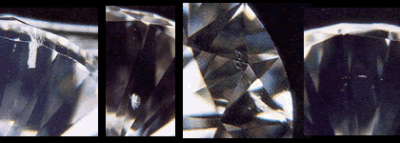It is helpful to know the different external and internal features of diamonds. External features in diamonds are called blemishes and internal features are called inclusions. It is especially useful to know which may weaken or strain the structure of diamonds. The visibility of any particular inclusion or blemish is dependent on its location in the diamond, the size of the feature and how different lighting conditions affect the feature.
Inclusions (Internal)
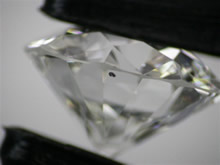 1. Crystal – A crystal is a mineral crystal contained in some diamonds. When the crystal is totally enclosed within the stone, it is called an included crystal. Crystals can be almost any size, colored or colorless, and can occur alone or in groups. You might hear people call crystals ‘bubbles’, but that term is incorrect for diamonds. Dark crystals are often called ‘carbon spots’, but that’s another incorrect and misleading term. Lighting conditions can impact the appearance of crystals. Under overhead lighting, included crystals and other near-colorless minerals often look black.
1. Crystal – A crystal is a mineral crystal contained in some diamonds. When the crystal is totally enclosed within the stone, it is called an included crystal. Crystals can be almost any size, colored or colorless, and can occur alone or in groups. You might hear people call crystals ‘bubbles’, but that term is incorrect for diamonds. Dark crystals are often called ‘carbon spots’, but that’s another incorrect and misleading term. Lighting conditions can impact the appearance of crystals. Under overhead lighting, included crystals and other near-colorless minerals often look black.
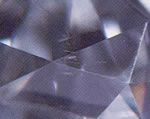 2. Needle – These long, thin crystal that look like a tiny rod at 10X magnification. A needle can appear white, bright, or dark.
2. Needle – These long, thin crystal that look like a tiny rod at 10X magnification. A needle can appear white, bright, or dark.
3. Pinpoint – A pinpoint is a very small crystal that looks like a tiny dot at 10X magnification. Pinpoints are most often white, but they can occasionally be dark.
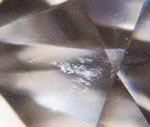 4. Cloud – A cloud consists of many tightly grouped pinpoints. The pinpoints might be too small to distinguish individually at 10X, but together they look like wispy white or gray patches. Some clouds look like a light haze, while others are dense and almost impossible to see through.
4. Cloud – A cloud consists of many tightly grouped pinpoints. The pinpoints might be too small to distinguish individually at 10X, but together they look like wispy white or gray patches. Some clouds look like a light haze, while others are dense and almost impossible to see through.
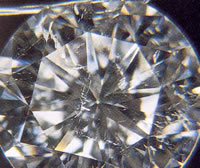 5. Twinning Wisp – The twinning wisp is an inclusion resulting from crystal distortion during growth. It is a series of pinpoints, clouds, or crystals that forms in a twinned diamond’s growth plane. Twinning wisps appear flat and ribbon-like, and usually radiate out from the diamond’s center.
5. Twinning Wisp – The twinning wisp is an inclusion resulting from crystal distortion during growth. It is a series of pinpoints, clouds, or crystals that forms in a twinned diamond’s growth plane. Twinning wisps appear flat and ribbon-like, and usually radiate out from the diamond’s center.
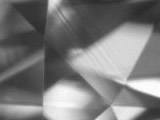 6. Internal Graining – Internal graining is also caused by irregularities in crystal growth. Its appearance can take the form of lines, angles, or curves, and it might be whitish, colored, or reflective. Internal graining can give part or all of the stone a hazy texture. It might be composed of fine, colorless lines that look like creases in cellophane. It might also look like a thin sheet of reflective plastic inserted into the stone, or like fine white or colored streaks. Some types of internal graining resemble falling rain or sleet, while others might look like vinegar in oil. These growth lines are usually hard to detect in diamonds.
6. Internal Graining – Internal graining is also caused by irregularities in crystal growth. Its appearance can take the form of lines, angles, or curves, and it might be whitish, colored, or reflective. Internal graining can give part or all of the stone a hazy texture. It might be composed of fine, colorless lines that look like creases in cellophane. It might also look like a thin sheet of reflective plastic inserted into the stone, or like fine white or colored streaks. Some types of internal graining resemble falling rain or sleet, while others might look like vinegar in oil. These growth lines are usually hard to detect in diamonds.
7. Grain Center – The grain center is a small, concentrated area of crystal growth distortion. It can be white or dark, and it might have a thread-like or pinpoint-like appearance. Grain centers can look like transparent tornadoes caught deep inside the diamond. They can occur alone or in groups. They are not visible from all directions, so they can disappear and reappear as you rock the diamond or move it from side to side.
8. Feather – A feather is a general term for any break in a diamond. Cleavage is a break that occurs in a cleavage plane- a week crystal direction along one or more of a diamond’s four octahedral planes. A break in any other direction is called a fracture. Breaks along cleavage planes often have a ribbed or feather-like appearance. A feather might look shiny and white, glossy, or transparent, depending on the viewing direction. Some feathers catch the light and blink from transparent to bright when you rock the stone. Feathers can present more of a durability problem than any other inclusion because a hard knock can make them larger.
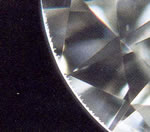 9. Bearded Girdle – A bearded girdle consists of minute feathers that extend from the girdle surface into the stone. A lightly bearded girdle has a few very fine feathers scattered around the diamond’s perimeter. A heavily bearded girdle has so many feathers that they create a fuzzy gray fringe all the way around the stone.
9. Bearded Girdle – A bearded girdle consists of minute feathers that extend from the girdle surface into the stone. A lightly bearded girdle has a few very fine feathers scattered around the diamond’s perimeter. A heavily bearded girdle has so many feathers that they create a fuzzy gray fringe all the way around the stone.
10. Bruise – A bruise is a tiny area of impact accompanied by small root-like feathers visible at 10X magnification. When viewed through an opposing facet, a bruise appears cottony in texture as it radiates into the diamond. A bruise is sometimes called a percussion mark and is cause by a hard blow.
11. Knot – A knot is an included diamond crystal that extends to the surface after cutting and polishing. With magnification and proper lighting, you can see the boundary between a knot and its host diamond. Knots sometimes look like slightly raised areas on a facet. In reflected light, you might see the know outline in what is usually a rectangular shape. You might also see drag lines on one side of a knot where minute fragments of diamond are unintentionally dragged across the surface by the polishing wheel.
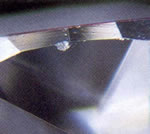 12. Chip – A chip is a shallow opening on the surface that typically has a rounded outline. A chip is the result of damage that occurs after cutting and polishing so it will not be accompanied by drag lines.
12. Chip – A chip is a shallow opening on the surface that typically has a rounded outline. A chip is the result of damage that occurs after cutting and polishing so it will not be accompanied by drag lines.
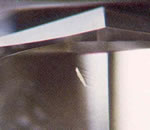 13. Cavity – A cavity is the space left when a surface-reaching crystal drops out or is forced out during polishing. It can also result when part of a feather breaks away and leaves a deep, angular opening. A cavity is usually distinguishable from a chip in that it usually has drag lines visible to one side of the cavity where minute diamond particles are dragged across the diamond surface by the polishing wheel.
13. Cavity – A cavity is the space left when a surface-reaching crystal drops out or is forced out during polishing. It can also result when part of a feather breaks away and leaves a deep, angular opening. A cavity is usually distinguishable from a chip in that it usually has drag lines visible to one side of the cavity where minute diamond particles are dragged across the diamond surface by the polishing wheel.
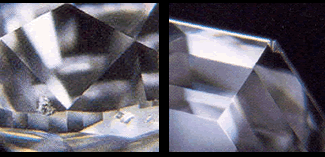 14. Indented Natural – An indented natural is a portion of the original rough diamond crystal surface, or skin, which dips below the polished diamond’s surface. The original surface of the diamond’s skin might have growth markings that look like triangles (trigons) or parallel grooves.
14. Indented Natural – An indented natural is a portion of the original rough diamond crystal surface, or skin, which dips below the polished diamond’s surface. The original surface of the diamond’s skin might have growth markings that look like triangles (trigons) or parallel grooves.
Chips, cavities and indented naturals can be difficult to distinguish from each other even with 10X magnification.
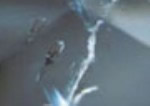 15. Laser Drill-Hole – The laser drill-hole is a tiny tunnel produced by a laser beam. The tunnel extends from the surface to a dark included crystal. After drilling, a technician might introduce acid into the surface-reaching drill-hole or feather to dissolve or bleach the inclusion and make it less visible. The GIA grades laser-drilled diamonds because the holes are permanent features and notes the drilling under comments.
15. Laser Drill-Hole – The laser drill-hole is a tiny tunnel produced by a laser beam. The tunnel extends from the surface to a dark included crystal. After drilling, a technician might introduce acid into the surface-reaching drill-hole or feather to dissolve or bleach the inclusion and make it less visible. The GIA grades laser-drilled diamonds because the holes are permanent features and notes the drilling under comments.
16. Fracture Filled – Laser drill holes and surface-reaching feathers are sometimes filled with a molten glass substance in a treatment called fracture filling. The filler makes the characteristic less apparent. It can be difficult to detect, but the treatment leaves a telltale sign called the flash effect. Look for the irregularity, and then rock the diamond back and forth. If the stone is filled, you will see a flash of color that changes to a second color when you tilt the stone. The GIA does not grade fracture filled diamonds because the treatment is not permanent.
Blemishes (External)
1. Abrasion – An abrasion is a series of minute nicks along a facet junction. It gives the junction a white or fuzzy appearance. Abrasions usually occur because people handle and store jewelry carelessly, and the diamonds rub against each other.
2. Pit – A pit is a small characteristic that usually looks like a tiny white dot. Pits usually result when pinpoint inclusions are pulled from the diamond during the polishing process. In other words, a pit is a tiny cavity.
3. Nicks – Nicks are minor surface chips caused by abrasion due to long and hard wear. Most nicks occur along the girdle; however, they may also appear along the facet junctions or elsewhere. A nick can weaken the diamond such that a hard blow may extend additional fractures from the base of the cavity.
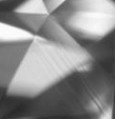 4. Twin Lines, Knot Lines or Surface Grain Lines – These are lines that are caused by twinning or by large inclusions that are oriented differently from the main crystal. They stand out as visible lines at the surface. Twinning lines or knot lines are distinguished easily from polishing marks by the fact that they run across facet junctions. These should not be confused with crystal growth lines, which are visible within the diamond, instead of on the surface. The words “Surface grain lines are not shown” on AGS grading reports and “Surface graining is not shown” on GIA grading report are frequent comments. Grain lines are created by irregular crystallization that takes place when a diamond is formed. All diamonds have graining. A diamond that is graded Internally Flawless can have internal graining and as long as it’s transparent will not affect the clarity grade unless they are present in large masses. These surface grain lines are seldom visible to the eye and typically very minor in importance even though mention of them in the comments section of certifications draws a lot of attention.
4. Twin Lines, Knot Lines or Surface Grain Lines – These are lines that are caused by twinning or by large inclusions that are oriented differently from the main crystal. They stand out as visible lines at the surface. Twinning lines or knot lines are distinguished easily from polishing marks by the fact that they run across facet junctions. These should not be confused with crystal growth lines, which are visible within the diamond, instead of on the surface. The words “Surface grain lines are not shown” on AGS grading reports and “Surface graining is not shown” on GIA grading report are frequent comments. Grain lines are created by irregular crystallization that takes place when a diamond is formed. All diamonds have graining. A diamond that is graded Internally Flawless can have internal graining and as long as it’s transparent will not affect the clarity grade unless they are present in large masses. These surface grain lines are seldom visible to the eye and typically very minor in importance even though mention of them in the comments section of certifications draws a lot of attention.
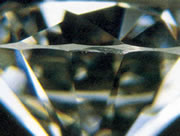 5. Naturals – A natural is an unpolished surface on a finished diamond that is part of the surface or “skin” of the rough crystal from which the stone was cut. Naturals are usually found on or near the girdle. The term “indented natural” is used to describe a natural that extends onto the crown or pavilion. The “skin” of a rough diamond has a texture of serrated lines or small triangles known as trigons. This texture is visible on naturals when viewed with a microscope. Naturals are not a danger to your diamonds because they have always been there and are not a result of trauma or fracture.
5. Naturals – A natural is an unpolished surface on a finished diamond that is part of the surface or “skin” of the rough crystal from which the stone was cut. Naturals are usually found on or near the girdle. The term “indented natural” is used to describe a natural that extends onto the crown or pavilion. The “skin” of a rough diamond has a texture of serrated lines or small triangles known as trigons. This texture is visible on naturals when viewed with a microscope. Naturals are not a danger to your diamonds because they have always been there and are not a result of trauma or fracture.
 6. Scratches and Wheel Marks – Loose diamonds that are stored in the fold over diamond papers used by diamond merchants are likely to have their facet junctions become abraded and scratches may also appear on the diamonds. Scratches may also result from wear or contact with other diamonds in a jewelry box. In a well finished diamond, the grooves left by the rough grinding process are polished out. In hastily polished diamonds, prominent grooves called “wheel marks” are often left and can cause diffraction and loss of brilliancy. These scratches do not impact the durability of the diamond.
6. Scratches and Wheel Marks – Loose diamonds that are stored in the fold over diamond papers used by diamond merchants are likely to have their facet junctions become abraded and scratches may also appear on the diamonds. Scratches may also result from wear or contact with other diamonds in a jewelry box. In a well finished diamond, the grooves left by the rough grinding process are polished out. In hastily polished diamonds, prominent grooves called “wheel marks” are often left and can cause diffraction and loss of brilliancy. These scratches do not impact the durability of the diamond.
7. Extra Facets – Extra facets are those additional facets that are placed on a diamond without regard for the diamond’s symmetry. These facets are in addition to those needed to fulfill the requirements of the brilliant or step cut style. They are commonly used to polish out a minor blemish such as a natural or a nick. Extra facets are not considered in determining a clarity grade. In fact, diamonds with very high clarity grades often have many extra facets that were required to polish away the inclusions and blemishes to attain the high clarity grade. Extra facets have no impact on the durability of the diamond.
8. Rough Girdle – A rough girdle is one that has an irregular, granular, pitted girdle surface. A rough girdle is usually accompanied by bearding or feathering. The term rough girdle describes a girdle that appears waxy. It also describes a girdle that is badly pitted and even chipped. Beware of rough girdles because they are not only noticeable visually, they are not smooth to the touch and can be a sign of weakness in durability at the girdle.
9. Burn Marks – When a diamond is polished too rapidly, the heat caused by friction may build up enough so that the surface clouds slightly under the metal jaws holding the diamond. The surface of the diamond can also be burnt by exposure to a very hot fire such as a house fire or exposure to a torch in the setting process. These burn marks can usually be polished out and do not impact the durability of diamonds.

